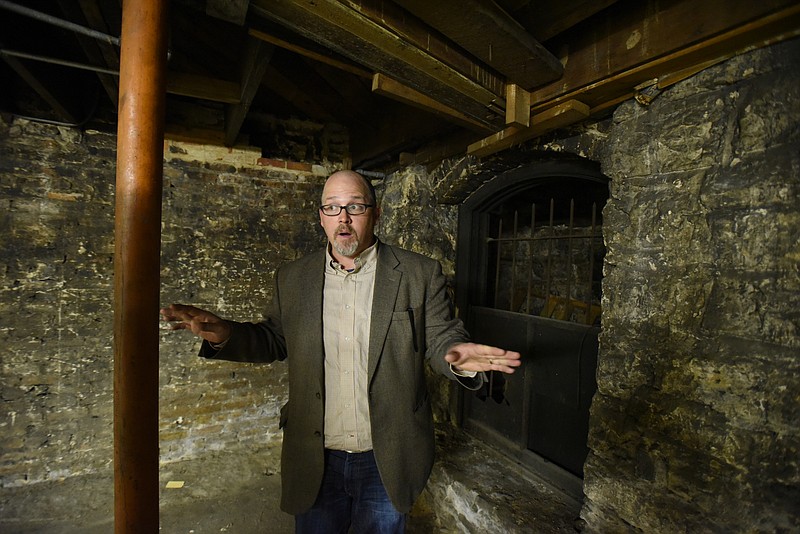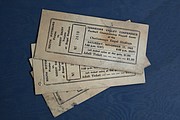Photo Gallery
Windows to the Past: Renovations uncover several old drawings on the walls of a Cherry Street building
Have any insight?
Do you have friends or family who worked in the building and might know who drew these cartoons and why? Do you recognize any comics or historic characters who may have inspired the cartoons? If you can offer some clues or leads, contact Lynda Edwards at ledwards@timesfreepress.com.
The workers broke through inches of concrete to get to the original 1887 brick walls at 719 Cherry St. earlier this year. That's when they first glimpsed the mysterious cartoons, pictures hand-drawn in black right onto the bricks. They must have been drawn before 1952 because a fire scorched the building that year and the owners plastered over the walls, covering the drawings where they hid for decades.
When Steve Fry from the Hamilton County Assessor's office was visiting the building, he was intrigued.
"The cartoon of the man in a bowler hat reminds me of a popular Chattanooga Times editorial cartoonist, Little Willie King," Fry says. "Every January 1st, the Times printed King's cartoon of Baby New Year wearing a bowler. The baby's body and hat were made of typed names of important or well-known local people. My Dad's name would be there."
King's popularity bloomed after 1952, but could he have doodled on the walls before that year? In research conducted by David Cooper, whose family owned two nearby buildings and who works on the copy desk at the Times Free Press, 719 Cherry St. housed Bob Green's Restaurant from 1938 until 1952. While it's possible that King could have doodled on the walls with the owner's permission, experts who reviewed the cartoons felt that the work was more on the level of a talented amateur rather than a professional.
Architect Craig Peavy is rehabbing 719 Cherry St. for his firm, but he plans to install clear plastic over the cartoons to keep them safe and visible. Photos of the cartoons were sent to sent to several experts in an effort to figure out who made them and why.
U.S. Library of Congress Curator Sara Duke's expertise includes advertising history as well as the history of American editorial cartoonists. She examined the photos and compared the images to those in several of her databases.
"The cartoons are rather rough, so my guess is that they were done by employees with a love of cartooning as an art form rather than a professional cartoonist," Duke says.
The building had dozens of tenants over the decades, including a spice maker, an office supply seller, several restaurants, a printer of books, newspapers and magazines. Even if they're mere lunch break doodles, the cartoons are a window onto Chattanooga's past attitudes toward race and class.
The Gypsy Peddler
A peddler sits inside a gypsy wagon, a kettle and cooking pot strapped to his horse-drawn home and cozy smoke drifting from the stovepipe on the roof. There is a poem handwritten next to the drawing. Sadly though, most of the poem was accidentally destroyed during renovation, but what can be read says, "Too all my wares " then on the second line, "The heart is " The ends of the lines are worn away.
"There was a gypsy encampment on Forest Hill from the 1880s through the 1920s and many of them had wagons and used to travel through neighborhoods selling items," Chattanooga Public Library Archivist and Librarian Suzette Rainey says. "The Chattanooga Times described how they performed music and put on shows with a trained bear. They were harassed by police and locals who were afraid gypsies would burglarize homes or commit other crimes."
Gypsies are also known as Romani people believed to be descended from nomads in Northern India, Spain and Turkey; they often suffered bigotry against their ethnicity.
"The newspaper's coverage of gypsies was racially derogatory," Rainey says. "Some articles called them 'darkies.'"
Yet the drawing in 719 Cherry seems sympathetic and humane, done with details and care.
Donkey Kicks Man
The donkey is kicking a man who is clearly black and whose rolled-up pants legs indicate he is a laborer, not rich or idle. Is it an editorial cartoon?
The donkey was first associated with the Democratic Party by editorial cartoonist Thomas Nast in 1828. Southern Democrats were decidedly not known as anti-racist before 1952. But there were champions of progressive ideas in the area, including the Industrial Workers of the World or Wobblies, who urged labor unions to unite across racial and ethnic lines.
Still, it's not clear whether the cartoon is mocking the victim or sympathizing with him. The cartoon has a handwritten caption that refers to a "KO" or knockout but the other words were destroyed by the removal of the plaster from the wall.
"I don't think this is an editorial cartoon," Duke says. "There are a lot of images of African-Americans being bested by donkeys and mules. Currier & Ives had a pretty racist series called 'Darktown' that lampooned African-Americans moving north starting in the 1880s. Chattanooga is not north, but former slaves moving into the city to take industrial jobs may have received the same lampooning treatment."
Strutting Man in a Bowler Hat
Above and seemingly unrelated to the donkey is a short guy in a striped shirt with a bowler cocked over an eyebrow. One suspender is stretched diagonally across his chest like Pancho Villa's bullet-filled bandoleer.
"I think that's Kayo from the Moon Mullins comic strip; it's a very good likeness," says Ohio State University professor Jennie Robb, who has the fun of curating the Billy Ireland Cartoon Library & Museum, a priceless collection of political cartoons, 'zines, graphic novels and comics.
"Kayo dresses just like that, except his pants are polka-dotted, not black," he says.
Moon Mullins was a wildly successful comic that the Chicago Tribune launched in 1923. Moon is a hard-luck prizefighter who rooms in the Schmaltz Boarding House, where his kid brother, Kayo, sleeps in a dresser drawer. Moon's low-life buddies enlist him in sketchy schemes that spectacularly fail.
The Mullins were Irish at a time when prejudice against the Irish was rampant. Moon is constantly sucker-punched, but Kayo is cynical, smart and so quick with a razor-edged putdown he's impossible to see as a loser. He's more than a survivor, he's a good bet.
And the bowler hat is a signal and not just a head covering, according to fashion historians Annette Lynch and Michael Strauss in their book "Ethnic Dress in the United States."
"Prior to the development of the bowler, hats marked rather than blurred class distinctions," they write.
Top hats were too expensive to reproduce in mass numbers, but bowlers, worn by British royalty and the American uppercrust, proved easy to make. Working-class Americans, especially Irish immigrants, who wanted to assimilate and climb the career and social ladder loved bowlers. They saw the move from hard physical farm labor and road work to jobs in stores and offices as a grand step up.
From 1910 through the 1920s, "Ethnic Dress" explains, "the suit and the bowler hat became the standard and acceptable uniform of the American workingman; it afforded the immigrant the chance to look American and break into (this nation's) social life."
Plaid Man
"The image of the man in plaid resembles Happy Hooligan, who was a popular comic strip character starting in 1900," Duke says.
But Robb thinks the plaid man is too posh to be the hobo who never let poverty get him down.
"Happy wore a tin can on his head instead of a hat," Robb says. "The plaid guy in the drawing is much more prosperous, upscale. He's a bit of a dandy and looks too confident to be a hobo."
The drawing strikes Robb as being more of a compilation of figures, social-class markers and period hallmarks.
"There are certain tropes that were common to cartoons of that era, 1900 into the Great Depression, and the person who made the drawing is using some of those tropes common to many comic strips," Robb adds.
She sees the plaid suit as aspirational, a stylish way to stand out after years of keeping one's head down.
Bunny, Grazing Cow & Skippie the Odd-Looking Dog
These drawings of animals just pop up on the walls with no connection to others. Are they brand trademarks or the results of an ad campaign's brainstorming session?
"They don't look like ads to me," says Ann Gray, executive director of Cornerstones Inc., a nonprofit dedicated to preserving Chattanooga's architectural and historic gems.
All the experts tried to imagine under what circumstances employees in the building would be allowed to doodle across the brick walls in dark paint. Many bosses who occupied the building before 1952 don't always sound caring or understanding.
Architect Peavy recounts the story of a female worker whose arm was chopped off in the building's elevator by a piece of metal that fell from the rafters with the swiftness of a guillotine blade. And there's a huge metal door designed to slam shut when the air gets so hot that the wax latch holding it open melts.
"The problem is, it slams shut on the workers trapped on the other side," he says. "There weren't a lot of laws protecting workers in those days, so employers may not thought of it that much."
Now the only trace of those pre-World War II workers are the walls decorated with fragments of their dreams.
Contact Lynda Edwards at 423-757-6391 or ledwards@timesfreepress.com.

